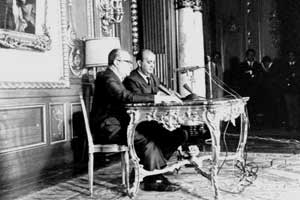Em Portugal, a grande mudança, a "revolução", começou em 1968 com uma mera queda de uma cadeira de lona. No dia 3 de agosto, Antonio de Oliveira Salazar deitou nessa cadeira mas caiu, bateu a cabeça e comprometeu sua saúde para o resto de seus dias. Ele não se sentiu bem depois da queda mas, como era costume em seu governo, a notícia foi mantida em segredo.Nem seu médico particular soube da queda no dia -- apenas três dias depois foi informado e só no dia 4 de setembro seu mais famoso paciente lhe disse que não se sentia bem. Dois dias mais tarde, apresentando piora, Salazar foi levado a um hospital, onde foi operado no dia 7 de setembro.
Com diagnóstico incerto, que variava de trombose cerebral a hematoma intracraniano,Salazar não melhorou com a cirurgia. E no dia 27 de setembro é substituído por Marcello Caetano. Não resistiu mais que dois anos e morreu em 1970.
Marcello Caetano ainda tentou a princípio manter a ditadura, em vão. A morte de Salazar foi o fim da ditadura.Problemas graves com as colônias somaram-se a reivindicações por mudanças dentro de Portugal e veio a Revolução dos Cravos em 1974, que mudou para sempre o país e o levou à democracia que permanece até hoje.
Portugal é um país único, com um povo único (como todos nós, brasileiros, estamos cansados de saber). E isso ficou evidente mais uma vez em 1968. O país começou a mudar radicalmente naquele ano, mas de uma maneira própria, original, quase casual. Foi uma queda de cabeça de um regime, que levantou o país.





